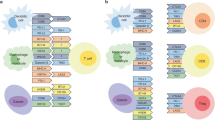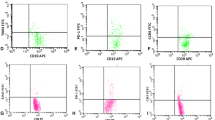Abstract
Immune checkpoint inhibition suggests promising progress for the treatment of advanced hepatocellular carcinoma (HCC). However, the underlying cellular mechanisms remain unclear because liver cancer cells apparently do not upregulate inhibitory checkpoint molecules. Here, we analysed whether regulatory T cells (Tregs) can alternatively trigger checkpoint inhibition pathways in HCC. Using flow cytometry we analysed expression of checkpoint molecules (PD-1, PD-L1, CTLA-4, GITR, Tim-3) on peripheral CD4+CD25+Foxp3+ Tregs and their secretion of inhibitory mediators (IL-10, IL-35, TGF-beta, galectin-9) in 116 individuals (50 patients with HCC, 41 non-tumour bearing liver disease controls, 25 healthy controls). Functional activity of Tregs on T effector cells (IFN-gamma production, cytotoxicity) was characterized in vitro using a lectin-dependent cellular cytotoxicity (LDCC) assay against checkpoint inhibitor-negative P815 target cells. Unlike liver patients without malignancy and healthy controls, the frequency of checkpoint inhibitor-positive Tregs inversely correlated to age of patients with HCC (PD-L1, p = 0.0080; CTLA-4, p = 0.0029) and corresponded to enhanced numbers of Tregs producing IL-10 and IL-35 (p < 0.05 each). Tregs inhibited IFN-gamma secretion and cytotoxicity of CD8+ T cells when added to LDCC against P815 cells. Treg-induced inhibition of IFN-gamma secretion could be partially blocked by neutralizing PD-1 and PD-L1 antibodies specifically in HCC patients. In HCC peripheral Tregs upregulate checkpoint inhibitors and contribute to systemic immune dysfunction and antitumoural activity by several inhibitory pathways, presumably facilitating tumour development at young age. Blocking PD-L1/PD-1 interactions in vitro selectively interfered with inhibitory Treg -T effector cell interactions in the patients with HCC and resulted in improved antitumoural activity also against checkpoint inhibitor-negative tumour cells.




Similar content being viewed by others
Abbreviations
- ALT:
-
Alanine aminotransferase
- BFA:
-
Brefeldin A
- Con A:
-
Concanavalin A
- CT:
-
Computer tomography
- CTLA-4:
-
Cytolytic T lymphocyte-associated antigen
- FACS:
-
Fluorescence-activated cell sorting
- FMO:
-
Fluorescence minus one
- Foxp3:
-
Forkhead box p3
- GITR:
-
Glucocorticoid-induced TNFR family-related gene
- HCC:
-
Hepatocellular carcinoma
- HPF:
-
High power field
- IFN:
-
Interferon
- IL:
-
Interleukin
- LDCC:
-
Lectin-dependent cellular cytotoxicity
- MRI:
-
Magnetic resonance imaging
- NASH:
-
Non-alcoholic steatohepatitis
- NK cell:
-
Natural killer cell
- PBMC:
-
Peripheral blood mononuclear cells
- PBS:
-
Phosphate-buffered saline
- PD-1:
-
Programmed death 1 receptor
- PD-L1:
-
Programmed death ligand 1
- PD-L2:
-
Programmed death ligand 2
- TGF:
-
Transforming growth factor
- Tim-3:
-
T cell immunoglobulin and mucin-domain containing-3
- Treg:
-
Regulatory T cell
References
Langhans B, Nischalke HD, Krämer B et al (2019) Role of regulatory T cells and checkpoint inhibition in hepatocellular carcinoma. J Hepatol 70(Suppl):e377 (abstract number THU-492)
El-Serag HB (2011) Hepatocellular carcinoma. N Engl J Med 365:1118–1127
Wallace MC, Preen D, Jeffrey GP et al (2015) The evolving epidemiology of hepatocellular carcinoma: a global perspective. Expert Rev Gastroenterol Hepatol 9:765–779
Siegel RL, Miller KD, Jemal A (2018) Cancer statistics, 2018. CA Cancer J Clin 68:7–30
Llovet JM, Zucman-Rossi J, Pikarsky E et al (2016) Hepatocellular carcinoma. Nat Rev Dis Primer 2:16018
Prieto J, Melero I, Sangro B (2015) Immunological landscape and immunotherapy of hepatocellular carcinoma. Nat Rev Gastroenterol Hepatol 12:681–700
Elsegood CL, Tirnitz-Parker JE, Olynyk JK et al (2017) Immune checkpoint inhibition: prospects for prevention and therapy of hepatocellular carcinoma. Clin Transl Immunol 6:e161
Nishida N, Kudo M (2018) Immune checkpoint blockade for the treatment of human hepatocellular carcinoma. Hepatol Res Off J Jpn Soc Hepatol 48:622–634
Chen L, Flies DB (2013) Molecular mechanisms of T cell co-stimulation and co-inhibition. Nat Rev Immunol 13:227–242
Freeman GJ, Long AJ, Iwai Y et al (2000) Engagement of the PD-1 immunoinhibitory receptor by a novel B7 family member leads to negative regulation of lymphocyte activation. J Exp Med 192:1027–1034
Iwai Y, Ishida M, Tanaka Y et al (2002) Involvement of PD-L1 on tumor cells in the escape from host immune system and tumor immunotherapy by PD-L1 blockade. Proc Natl Acad Sci USA 99:12293–12297
Popovic A, Jaffee EM, Zaidi N (2018) Emerging strategies for combination checkpoint modulators in cancer immunotherapy. J Clin Investig 128:3209–3218
Hargadon KM, Johnson CE, Williams CJ (2018) Immune checkpoint blockade therapy for cancer: an overview of FDA-approved immune checkpoint inhibitors. Int Immunopharmacol 62:29–39
Shi F, Shi M, Zeng Z et al (2011) PD-1 and PD-L1 upregulation promotes CD8(+) T-cell apoptosis and postoperative recurrence in hepatocellular carcinoma patients. Int J Cancer 128:887–896
Kim H-D, Song G-W, Park S et al (2018) Association between expression level of PD1 by tumor-infiltrating CD8+ T cells and features of hepatocellular carcinoma. Gastroenterology 155(6):1936–1950.e17
Unitt E, Marshall A, Gelson W et al (2006) Tumour lymphocytic infiltrate and recurrence of hepatocellular carcinoma following liver transplantation. J Hepatol 45:246–253
Budhu A, Forgues M, Ye Q-H et al (2006) Prediction of venous metastases, recurrence, and prognosis in hepatocellular carcinoma based on a unique immune response signature of the liver microenvironment. Cancer Cell 10:99–111
Brandacher G, Winkler C, Schroecksnadel K et al (2006) Antitumoral activity of interferon-gamma involved in impaired immune function in cancer patients. Curr Drug Metab 7:599–612
Okazaki T, Honjo T (2007) PD-1 and PD-1 ligands: from discovery to clinical application. Int Immunol 19:813–824
El-Khoueiry AB, Sangro B, Yau T et al (2017) Nivolumab in patients with advanced hepatocellular carcinoma (CheckMate 040): an open-label, non-comparative, phase 1/2 dose escalation and expansion trial. Lancet Lond Engl 389:2492–2502
Zhu AX, Finn RS, Edeline J et al (2018) Pembrolizumab in patients with advanced hepatocellular carcinoma previously treated with sorafenib (KEYNOTE-224): a non-randomised, open-label phase 2 trial. Lancet Oncol 19:940–952
Kalathil S, Lugade AA, Miller A et al (2013) Higher frequencies of GARP(+)CTLA-4(+)Foxp3(+) T regulatory cells and myeloid-derived suppressor cells in hepatocellular carcinoma patients are associated with impaired T-cell functionality. Cancer Res 73:2435–2444
Yeung OWH, Lo C-M, Ling C-C et al (2015) Alternatively activated (M2) macrophages promote tumour growth and invasiveness in hepatocellular carcinoma. J Hepatol 62:607–616
Iwata T, Kondo Y, Kimura O et al (2016) PD-L1 + MDSCs are increased in HCC patients and induced by soluble factor in the tumor microenvironment. Sci Rep 6:39296
Greten TF, Sangro B (2017) Targets for immunotherapy of liver cancer. J Hepatol 18:1–20
Shitara K, Nishikawa H (2018) Regulatory T cells: a potential target in cancer immunotherapy. Ann N Y Acad Sci 1417:104–115
Shevach EM, Thornton AM (2014) tTregs, pTregs, and iTregs: similarities and differences. Immunol Rev 259:88–102
Wang F, Wan L, Zhang C et al (2009) Tim-3-Galectin-9 pathway involves the suppression induced by CD4 + CD25 + regulatory T cells. Immunobiology 214:342–349
Sakaguchi S, Miyara M, Costantino CM et al (2010) FOXP3 + regulatory T cells in the human immune system. Nat Rev Immunol 10:490–500
Heimbach JK, Kulik LM, Finn RS et al (2018) AASLD guidelines for the treatment of hepatocellular carcinoma. Hepatol Baltim Md 67:358–380
Perl A, González-Cabello R, Onody K et al (1986) Independence of depressed lectin-dependent cell-mediated cytotoxicity from interleukin 2 production in patients with systemic lupus erythematosus. Clin Exp Immunol 65:286–292
Tsukishiro T, Shimizu Y, Higuchi K et al (2000) Effect of branched-chain amino acids on the composition and cytolytic activity of liver-associated lymphocytes in rats. J Gastroenterol Hepatol 15:849–859
Mayer E, Bannert C, Gruber S et al (2012) Cord blood derived CD4 + CD25(high) T cells become functional regulatory T cells upon antigen encounter. PLoS One 7:e29355
Llovet JM, Montal R, Sia D et al (2018) Molecular therapies and precision medicine for hepatocellular carcinoma. Nat Rev Clin Oncol 15(10):599–616
Shrestha R, Prithviraj P, Anaka M et al (2018) Monitoring immune checkpoint regulators as predictive biomarkers in hepatocellular carcinoma. Front Oncol 8:269
Iñarrairaegui M, Melero I, Sangro B (2018) Immunotherapy of hepatocellular carcinoma: facts and hopes. Clin Cancer Res Off J Am Assoc Cancer Res 24:1518–1524
Semaan A, Dietrich D, Bergheim D et al (2017) CXCL12 expression and PD-L1 expression serve as prognostic biomarkers in HCC and are induced by hypoxia. Virchows Arch Int J Pathol 470:185–196
Zhou G, Sprengers D, Boor PPC et al (2017) Antibodies against immune checkpoint molecules restore functions of tumor-infiltrating T cells in hepatocellular carcinomas. Gastroenterology 153(1107–1119):e10
Calderaro J, Rousseau B, Amaddeo G et al (2016) Programmed death ligand 1 expression in hepatocellular carcinoma: relationship with clinical and pathological features. Hepatol Baltim Md 64:2038–2046
Langhans B, Braunschweiger I, Arndt S et al (2010) Core-specific adaptive regulatory T-cells in different outcomes of hepatitis C. Clin Sci Lond Engl 119:97–109
Langhans B, Krämer B, Louis M et al (2013) Intrahepatic IL-8 producing Foxp3+CD4+ regulatory T cells and fibrogenesis in chronic hepatitis C. J Hepatol 59:229–235
Kobayashi N, Hiraoka N, Yamagami W et al (2007) FOXP3 + regulatory T cells affect the development and progression of hepatocarcinogenesis. Clin Cancer Res 13:902–911
Lin SZ, Chen KJ, Xu ZY et al (2013) Prediction of recurrence and survival in hepatocellular carcinoma based on two Cox models mainly determined by FoxP3 + regulatory T cells. Cancer Prev Res Phila 6:594–602
Zhang A-B, Qian Y-G, Zheng S-S (2016) Prognostic significance of regulatory T lymphocytes in patients with hepatocellular carcinoma. J Zhejiang Univ Sci B 17:984–991
Ribas A, Shin DS, Zaretsky J et al (2016) PD-1 blockade expands intratumoral memory T cells. Cancer Immunol Res 4:194–203
Toor SM, Syed Khaja AS, Alkurd I et al (2018) In-vitro effect of pembrolizumab on different T regulatory cell subsets. Clin Exp Immunol 191:189–197
Acknowledgements
The authors thank Ingrid Braunschweiger, Eva-Maria Schumacher and Susanne Steiner for their perfect technical assistance.
Funding
This work was supported by the German Center for Infection Research [to B. Langhans, L. Dold and U. Spengler (TTU 05.808)], the German Research Foundation (SFB/TRR57 to U. Spengler and J. Nattermann), and the Deutsche Krebshilfe [to U. Spengler and H.D. Nischalke (70112169), to M.A. Gonzalez-Carmona (109255)]. The study sponsors had no role in the study design, collection, analysis, and interpretation of data.
Author information
Authors and Affiliations
Contributions
BL, LD, PL, RM, AV, JN, CPS, MAGC and US were involved in the study concept and design as well as in patient acquisition. BL, HDN, BK, AV, MT, AMEH, MAGC and US were involved in the acquisition, analysis, and interpretation of the data. BL, LD, MAGC and US drafted the manuscript, and all authors were involved in critical revision of the manuscript.
Corresponding author
Ethics declarations
Conflict of interest
The authors declare that they have no conflicts of interest.
Ethical approval and ethical standards
The study protocol conformed to the ethical guidelines of the 1975 Declaration of Helsinki and was approved by the Institutional Review Board of the Bonn University Ethics Committee (Approval #150/15).
Informed consent
All patients and healthy blood donors gave written informed consent prior to blood sample collection for the use of biomaterials and clinical data for scientific purposes.
Cell line authentication
The mouse mastocytoma cell line P815 and the various hepatoma cell lines HepG2, Hep3B, and Huh7 were purchased from the American Type Culture Collection (ATCC®) TIB64™. Cell lines Huh4 and HepT1 were a kind gift of W. Caselmann and T. Pietsch, respectively. Cell line authentication for human HepG2, Hep3B, Huh7, Huh4, and HepT1 was not necessary, because these cell lines were excluded from our in vitro studies due to up-regulation of PD-L1/L2 in cell culture. Cell line authentication of murine P815 cells was performed by the Swiss DNA company Microsynth (Supplementary Table 3).
Additional information
Publisher's Note
Springer Nature remains neutral with regard to jurisdictional claims in published maps and institutional affiliations.
Electronic supplementary material
Below is the link to the electronic supplementary material.
Rights and permissions
About this article
Cite this article
Langhans, B., Nischalke, H.D., Krämer, B. et al. Role of regulatory T cells and checkpoint inhibition in hepatocellular carcinoma. Cancer Immunol Immunother 68, 2055–2066 (2019). https://doi.org/10.1007/s00262-019-02427-4
Received:
Accepted:
Published:
Issue Date:
DOI: https://doi.org/10.1007/s00262-019-02427-4




